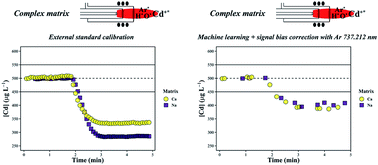Non-analyte signals and supervised learning to evaluate matrix effects and predict analyte recoveries in inductively coupled plasma optical emission spectrometry†
Abstract
A supervised data-driven methodology was used to evaluate matrix effect severity and the consequent analytical signal bias caused by easily ionizable elements (EIEs) in inductively coupled plasma optical emission spectrometry (ICP OES). Eight different supervised machine learning models were trained on signals from nine plasma naturally-occurring species of Ar, H and O to predict analyte recoveries for Cd, Co, Cr and Pb. The Ar atomic line at 737.212 nm was then used to correct for analytical signal bias due to matrix effects caused by high concentrations of Ca and Na. Recoveries were accurately predicted for all analytes (R2 > 0.9) by optimized generalized linear models (GLMs), regularized GLMs and partial least squares (PLS) regression. Accuracy was improved by employing Ar or Y as internal standards (IS). Although Y outperformed Ar in Cd determinations, both species were comparable for Co, Cr and Pb. In this preliminary study, however, there was no significant accuracy improvement observed when utilizing the Ar 737.212 nm line at the discretion of machine learning models. Therefore, for the analytes and matrices evaluated here, this species should be simply used as an IS when optimized models predict absolute errors < 0.3 (30%). The methodology described in this study may be easily implemented in routine applications, as one simply needs to monitor non-analyte signals while performing external standard calibration (EC). Once a series of models are trained, instrument software can be programmed to monitor plasma native species in real time and alert the analyst to different levels of matrix effect severity. Based on analyte recovery predictions from the optimized models, the analyst can then choose between simple EC, internal standardization with the Ar 737.212 nm line, or a more robust matrix-matching strategy.

- This article is part of the themed collection: JAAS Emerging Investigator Lectureship winners


 Please wait while we load your content...
Please wait while we load your content...